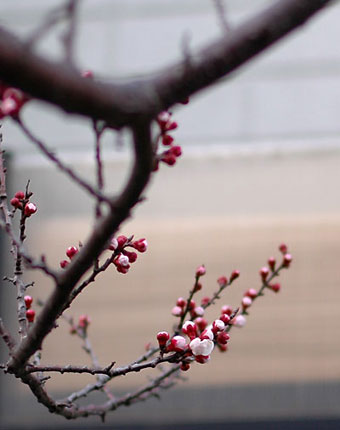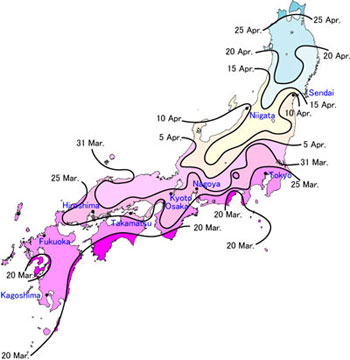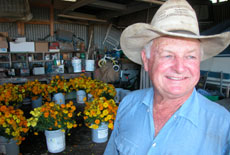Human Flower Project
Predicting Sakura
By on February 28th, 2022 in
Sunday, March 26, 2006
Predicting Sakura
Two Japanese weather services vie to specify when the cherry blossoms will open.

Early cherry blossom (March 15), Japan
Photo: Media Tinker
The Japanese sense of natural beauty (as Masashi Yamaguchi recently discussed right here) is keen and refined. Its most famous manifestation comes each spring with Hanami, the viewing of cherry blossoms across the islands. The two-day bloom is fittingly seen as a national miracle; with ardor and rigor the Japanese pour into parks and gardens, renewing the old rituals of looking, drinking, feasting, and singing—once “Aristocrats Only”—with newfangled accessories like plastic tarpaulins and digitals cameras.
Sakura blooms at Nature’s whim, and that indeterminacy seems only to whet the Japanese insistence on precision. Mari Yamaguchi, for AP, describes how two groups of Japanese meteorologists are fervently competing to pinpoint bloom-times across the nation.
“Our mission is so important I don’t have time to enjoy the flowers when we spot them,” said a fretful Eishin Murakata of Japan’s Meteorological Agency. Last year, the “The Met Office” blew it—predicting the cherry bloom four days too early. Yamaguchi writes that this inaccuracy caused “outrage” across Japan and emboldened sky-reading rivals. The strongest is Weather News. Its sakura site is dazzling (if a bit hard for English-speaking visitors to comprehend). Yamaguchi notes that it “gives real-time cherry blossom condition reports, so visitors can click on an area and find out if it’s time to pack a picnic basket—a service the Meteorological Agency does not provide.”
Japan’s Meteorological Agency has some impressive graphics too, a detailed, dated and updated chart of the sakura “front” as it moves northward.
 Takashi Nakamura, director of Japan’s Meteorological Agency, describes whiz-bang improvements in forecasting cherry blooms.
Takashi Nakamura, director of Japan’s Meteorological Agency, describes whiz-bang improvements in forecasting cherry blooms.
Photo: Katsumi Kasahara, for AP
According to Get Hiroshima, the Met Office began its cherry blossom forecasts about 50 years ago; upstart Weather News has been at it only four years. This blogger gives a better sense of why—in addition to core fastidiousness—the Japanese would hanker for such precision about their trees.
“One bento maker sells about 5000 hanami bentos on a good day during the short season. People like this are hoping for a later cherry blossom season, after the thousands of workers who have to move to new locations in the annual tenkin job transfer migration have settled in, and can turn their thoughts to getting wasted under cherry trees, and spending some cash in the process.”
An article from Xinhua notes that some travel agents even offer “sakura insurance,” lest the best-laid plans don’t coincide with peak blossom times.
 Sakura schedule, from the “Met Office”
Sakura schedule, from the “Met Office”
Image: Japan Meteorological Agency
So when WILL the sakura bloom? “There was a discrepancy of no less than 10 days between blossoming dates predicted by the two organizations. The Meteorological Agency predicted the flowers would begin to bloom (3/20), while Weather News said it would happen on March 31.” Check out both the Met Office and Weather News maps, above, for your location; then make your best guess and snag your bento accordingly.
If you’re less enchanted with flowers than with money, you’ll hope that the Met Office is on target this year. We understand that early sakura blooms “tend to coincide with economic gains.”
(Stateside, Washington, D.C.‘s cherry blossom festival began yesterday. Get a move on: Peak blooms today through Tuesday.)
Amid all the jockeying to time the cherry bloom right, the Japanese may be in denial about a dangerous mold—“witches broom.” The nation’s Flower Association discovered late last year that this disease has infected cherry trees in “18 of the nation’s 47 prefectures” and could wipe out Japan’s beloved sakura within 10 years! The mold “slowly devours cherry trees by first taking away their ability to produce flowers, Kyodo News Agency reported.”
The Flower Association has recommended removing the lesions from infected trees before the problem becomes rampant. Talk about “get a move on…”
Art & Media • Culture & Society • Gardening & Landscape • Secular Customs • Travel • Permalink




